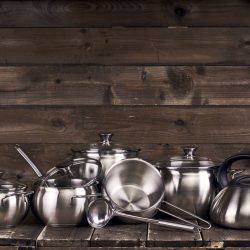![]() In recent years, silicone and nylon have become the dominant materials used in synthetic kitchen utensils. While both of these materials are gentle on non-stick surfaces, they offer slightly different features at different price-points. If you’re curious about the distinctions between nylon and silicone, then you’ve got to check out the research we’ve done on the subject.
In recent years, silicone and nylon have become the dominant materials used in synthetic kitchen utensils. While both of these materials are gentle on non-stick surfaces, they offer slightly different features at different price-points. If you’re curious about the distinctions between nylon and silicone, then you’ve got to check out the research we’ve done on the subject.
Most chefs prefer silicone over nylon because it poses less of a health risk and has higher heat resistance. Nylon utensils, however, are usually affordable, sturdy, and have an average heat resistance of about 400° F.
For more details on the differences between nylon and silicone, be sure to read the information listed below.
Silicone And Nylon Utensils: Are They Safe?
For most customers, safety is the top priority when investing in silicone or nylon utensils. Since these products will come in direct contact with your food, it’s understandable why people would be concerned about their safety profiles. In this section, we’ll run through the most common safety-related questions to help you make an informed shopping decision.
Is Nylon Safe For Cooking Utensils?
Most of the debate surrounding nylon’s safety centers on a compound known as diaminodiphenylmethane (DDM). This chemical is sometimes found in black nylon utensils, especially products made in China.
Recent CDC studies suggested that mice exposed to high traces of DDM were more likely to develop cancer, kidney failure, and liver problems. Although these mice inhaled far more DDM than you would while cooking, it’s worth keeping in mind.
At this time, we don’t know how much damage low traces of DDM could have on humans. Until we have clinical trials that suggest otherwise, nylon is generally considered safe as long as it’s not melted or regularly exposed to temperatures over 400° F.
Is Nylon Toxic When Heated?
It’s possible nylon could release toxic substances like DDM when exposed to high temperatures. Remember that most nylon products are usually heat resistant to about 400° F, which is lower than the melting point for silicone.
Besides the potential for DDM exposure, nylon products are far more likely to crack versus silicone ones. Once cracks start to appear, it’s easy for food particles to get trapped and harbor bad bacteria. Of course, once nylon starts melting, it could leach potentially toxic chemicals into your foods.
To keep your nylon utensils in good shape, only expose it to heat under 400° F for short durations. Be sure to get rid of melted or cracked nylon utensils ASAP.
Do Nylon Spatulas Melt?
Yes, nylon spatulas could melt if they are frequently exposed to high temps. As already mentioned, nylon usually has a lower heat resistance compared with silicone. In general, nylon utensils shouldn’t be used on surfaces above 400°F unless the manufacturer states otherwise.
For those who are interested, Rachael Ray now puts out a highly reviewed red nylon set that can handle 400° F.
Click here to see more on Amazon.
Is Silicone Toxic When Heated?
Silicone has a very high melting point—usually well above 500° F. For this reason, there’s a low chance silicone will leach toxic compounds onto food when cooking or baking.
Indeed, the FDA currently places silicone in the “Generally Recognized as Safe” category. Doctors at Health Canada also state there aren’t any “known health hazards associated with silicone” and that silicone doesn’t “produce…hazardous fumes.”
Just because silicone is generally considered safe, however, doesn’t mean it’s inert. Indeed, a recent study put out by the FDA suggested silicone baby products could leach compounds known as siloxanes when exposed to alcohol.
While some people are concerned about siloxane exposure, there’s no hard evidence these compounds pose any significant health risks. Indeed, a 2016 study headed by the Medical University of Gdańsk concluded that most siloxanes appear to be “well tolerated by the human organism.”
For extra safety, ensure your silicone products have “food-grade” status. Silicone utensils verified as food-grade must contain zero additives and fillers.
U-Taste now puts out a set of food-grade silicone spatulas that can withstand 600°F.
Click here to see more on Amazon.
New Synthetics Versus Old Standards: A Few Secondary Considerations
Now that we’ve explored the safety issues associated with nylon and silicone, let’s see how they stack up against other materials. Below, we’ll compare these synthetics with plastic, stainless steel, and wooden utensils.
Are Silicone Utensils Better Than Plastic?
Yes, silicone utensils are often considered better than plastics. Here are some of the top advantages you’ll experience using silicone products:
- Silicone has a higher heat resistance compared with plastics.
- You can safely place silicones in the dishwasher without worrying about warping.
- Plastics aren’t as durable or long-lasting compared with silicone products.
- There are no potentially harmful chemicals like BPA in silicone utensils.
The only major benefit of using plastic over silicone is the price. Food-grade silicone containers are more expensive than plastics.
If you’re interested in learning more about the benefits and drawbacks and plastics, then you should check out this post: Is It Better To Store Food In Plastic, Glass, Or Stainless Steel?
What’s The Deal With Silicone On Steel?
Although stainless steel products are durable and easy to clean, they have two big disadvantages: they conduct heat, and they can scratch non-stick surfaces. To help overcome these drawbacks, manufacturers have begun placing silicone on their steel utensils.
While these steel-silicone products are quite handy, there is always a risk that the silicone layer will wear away over time. Once the steel starts poking out, you can’t use these utensils on non-stick surfaces.
Anyone interested in steel & silicone utensils should check out this kit put out by Home Hero.
Click here to see more on Amazon.
FYI: nylon is far sturdier than silicone, especially in thin layers. If you’re looking for a spatula to flip your flapjacks on non-stick surfaces, then it’s worthwhile looking into nylon models like this one.
Click here to see more on Amazon.
Why Are Wooden Utensils Still Around?
Despite all of the synthetic options now available, wooden utensils are still going strong. Here are a few reasons people still enjoy using these rather rustic products:
- Wood is inert; it won’t melt or leach potentially harmful chemicals.
- Unlike stainless steel, wood doesn’t conduct heat.
- It’s easy to get a firm grip on wooden utensils.
- You can safely use wooden utensils on non-stick surfaces.
On the downside, once you get a stain on a wooden spoon, it’s difficult to wipe it away. Plus, there’s always the risk of wood splinters and finish getting into your food. By contrast, silicone and nylon are easy to clean and highly resistant to stains.
While we’re on the subject of staining, you might be interested in this post: Can You Put Tomato Sauce in a Stainless Steel Bowl?
Nylon Or Silicone? – It’s Up To You!
As you can see, silicone has a lot of advantages over nylon. Not only does silicone have greater heat resistance, but it’s also more durable and contains lower concentrations of potential carcinogens. This doesn’t mean, however, silicone is right for everyone’s needs. Be sure to weigh your preferences against the information provided above.








![Cooking frittata with a green asparagus and parmesan on the oven, Are Pans Oven-Safe? [Even With Silicone Handles]](https://kitchenseer.com/wp-content/uploads/2022/07/Cooking-frittata-with-green-asparagus-and-parmesan-on-the-oven-250x250.jpg)